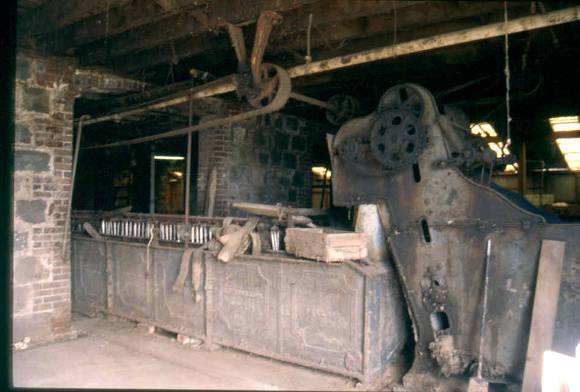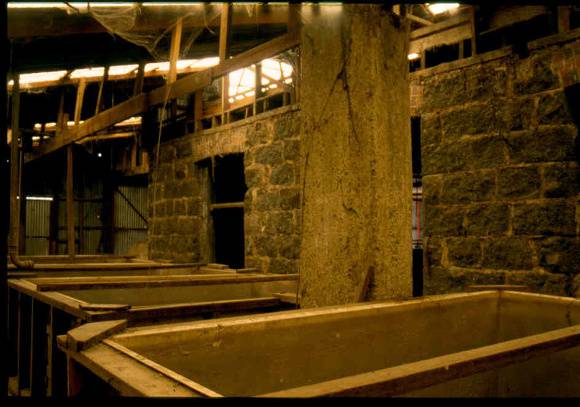| Back to search results » | Back to search page » |
|
SUNNYSIDE WOOL SCOUR
Statement of Significance
What is significant? In 1867 Haworth constructed a substantial building on the site to
house his fellmongering and wool washing and activities. The lower
floor of bluestone accommodates the scour line and sweating sheds for
skins, with the upper levels of timber under a corrugated iron roof,
used for drying. Substantial portions of this structure remain. The
river was used in part of the washing process. The brick and timber
drying house to the south may also have been built in this period. The existing brick chimney dates from the ownership of Haworth's son,
John, between 1899 and 1904. From 1904 on there were a succession of
owners, and the various timber sheds to the east were constructed at
different stages during this period to accommodate processes such as
drying, sweating and storage. The northern skillion was built before,
and the western skillion after, 1937. Much of the existing scouring equipment, including the locally
produced J. Dyson and Son scour vats, was installed in the period
between James Fowler's purchase of the property in 1945 and his death
in 1969. Remaining equipment including the locally produced Humble and
Sons squeeze rollers and wool feeder, the rotary steam dryer and the
dag crusher, contribute substantially to an understanding of the site.
The existing boiler and boiler house date from the 1960s. How is it significant? Why is it significant? The Sunnyside Wool Scour is of scientific (technological) importance
as it is an extraordinary example of an important nineteenth century
industrial activity. There are significant remains of the wool scour
building constructed in 1867, complemented by in-situ plant and
equipment which reflect the wool scouring process. The site also
incorporates a rare example of a decorated nineteenth century
industrial chimney stack which includes the insignia of its owner: the
initials 'JH' referring to John Haworth. The Sunnyside Wool Scour has significance for its archaeological
potential relating to the possible river-front archaeological remains
which could provide evidence of the earlier non-mechanised scouring
process. Significant machinery is retained on-site and this plant
demonstrates the talents of two prominent local engineering firms,
Humble and Sons and J. Dyson and Sons, and reflects the specialist
expertise they developed in the manufacture of wool processing
equipment. The site of the Sunnyside Wool Scour has been utilised as
both a wool scour and a fellmongery and has undergone a series of
developments, notably reflecting the advances in technology from a
hand operated process, in which the wool scouring was done at the
river bank using a pot stick method, to the construction of
substantial structures and the implementation of steam driven
machinery. More recently the site has been used for the purposes of
wool sorting and storing.
The land on which the Sunnyside Wool Scour
stands was first purchased in 1853 by John Ford Strachan, who was
involved in the Geelong wool trade. By 1862 the site had been
purchased by a Thomas Marshall, who was involved in the wool trade and
fellmongering. Although archaeological investigation may yield
evidence of use of the site for wool washing purposes during this
period, the first clearly documented use of the site for wool scouring
follows the purchase of the site by Edmund Haworth in 1866.
The Sunnyside Wool Scour is of historical,
scientific (technological) and social significance to the State of Victoria.
The Sunnyside Wool Scour is historically
and socially important at a State level as the only remaining business
associated with the major nineteenth century wool processing works
located at the Barwon breakwater. The siting of this industrial centre
is significant as it reflects environmental and community issues
associated with activities which produce a noxious by-product. The
Sunnyside Wool Scour went through an important period of development
during the time of its ownership by John Haworth who was a noted
Breakwater resident. The Sunnyside Wool Scour is a rare example of a
wool scouring establishment whose operations date from as early as the
1850s and which is represented by comparatively intact structural and
mechanical features.
Group
Farming and Grazing
Category
Woolscour


















